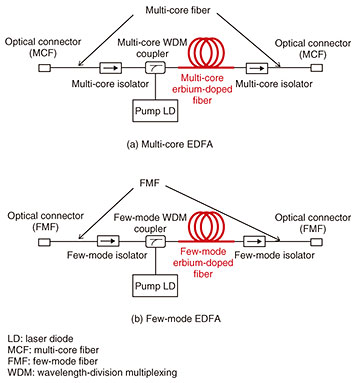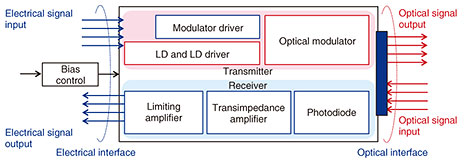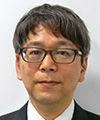 |
|||
|
|
|||
|
Global Standardization Activities Vol. 20, No. 4, pp. 74–79, Apr. 2022. https://doi.org/10.53829/ntr202204gls Standardization Activities Related to Fiber-optic Systems and Active Devices in International Electrotechnical CommissionAbstractThe International Electrotechnical Commission (IEC) Technical Committee (TC) 86 is making various international standards for optical-fiber communication. This article gives an overview of the standardization activities of IEC TC 86 and introduces the latest trends and future directions of the recently discussed topics related to fiber-optic systems and active devices. Keywords: International Electrotechnical Commission, standardization, fiber-optic systems, active devices 1. IntroductionAccelerated by the increased use of the Internet and datacenter interconnections, demand for optical communication systems and related components is increasing dramatically. As new technologies and products diversify, interconnection and quality assurance will become more important in the near future. International standards for interoperability and quality assurance of optical communication systems and related components are actively discussed in the International Telecommunication Union - Telecommunication Standardization Sector (ITU-T), the International Electrotechnical Commission (IEC), and the Institute of Electrical and Electronics Engineers (IEEE). This article gives an overview of the standardization trends of fiber-optic systems and active devices in IEC, which mainly deals with performance standards and test methods. 2. Organizational structure of IEC TC 86IEC was established in 1906 to set international standards in all technical fields related to electrical and electronic technologies. It makes international standards and provides standard conformity certifications for safety and quality assurance. Standardization in IEC is carried out in the following hierarchical structure: Standardization Management Board (SMB), which manages and directs standardization activities, Technical Committees (TCs), which are approved by SMB for each technical field and discuss the establishment and revision of international standards, Sub Committees (SCs), which discuss individual technical fields, and Working Groups (WGs), which discuss individual standard documents [1]. As of December 2021, 110 TCs and 102 SCs have been organized. TC 86 is responsible for fiber optics. As shown in Fig. 1, it consists of three SCs: SC 86A, which is mainly responsible for fibers and cables, SC 86B, which is mainly responsible for fiber-optic interconnecting devices and passive components, and SC 86C, which is mainly responsible for fiber-optic systems and active devices. In each field, each WG creates and revises international standards covering terms, characteristics, test methods, calibration and measurement methods, functional interfaces, and optical, environmental, and mechanical requirements. Figure 2 shows the organizational structure of TC 86. Twelve WGs are organized under the control of three SCs. This article describes the recent standardization trends of fiber-optic systems and active devices discussed in SC 86C.
3. Latest standardization activities of fiber-optic systems and active devices at SC 86CSC 86C is responsible for the standardization of performance standards and test methods for fiber-optic systems and active devices. In this section, we introduce the main topics and their discussion status at each WG. WG 1 deals with standards related to the physical layer of optical communication systems and subsystems and is proceeding with the standardization of optical-system test methods and design guidelines. This WG has been promoting the establishment of standards regarding optical subsystems (IEC 61280-4 series), such as loss-measurement methods for existing transmission lines using single-mode fiber and multi-mode fiber cables and for existing cables with MPO (multi-fiber push-on), which is a multi-core connector. It has also established standards for signal-quality measurement methods (IEC 61280-2 series), many of which are proposed from the Japan national committee. Recently, methods for measuring loss and return loss in passive optical network (PON) systems have been actively discussed. Figure 3 shows the PON system configuration and how to measure loss and return loss. Multiple measurement methods have been proposed, which are basically categorized into two major methods; a method that uses a light source and power meter and a method that uses an optical time-domain reflectometer (OTDR). For the former, how to specify the light source is discussed. For the latter, whether to measure in the upstream or downstream direction and whether to allow in-service measurement are discussed. The Japan national committee is leading the discussion from the viewpoint of reliability of actual network services by giving opinions, such as that the method using a light source and power meter is the reference test method, the method using OTDR is the alternative test method, and the in-service measurement is the supplementary test method and out of standard.
Standards and design guides that focus on digital coherent transmission systems are also under discussion. For instance, error-vector magnitude measurement methods for vector-modulated optical signals in digital coherent transmission systems and design guides for digital coherent transmitters and receivers have been proposed. We are proceeding with these discussions in collaboration with related SCs and ITU-T. Fiber optics are used not only in optical communication systems but also in non-communication areas, such as sensing. International standards for fiber-optic sensors using optical products are discussed at WG 2. Thus far, standards such as for strain distribution sensors (IEC 61757-1 series), temperature sensors (IEC 61757-2 series), and distributed acoustic sensors (IEC 61757-3 series) using fiber Bragg grating have been discussed, and the Japan national committee is actively expressing opinions and leading the discussions. WG 3 standardizes product standards and test methods for optical amplifiers and dynamic modules. We have been discussing a wide range of standards such as the definitions of the characteristic parameters of optical amplifiers and dynamic modules, measurement methods, reliability and safety standards, optical-amplifier performance-standard templates, and design guides. The Japan national committee has recently proposed a design guide for space-division-multiplexing optical amplifiers for spatial-multiplexing optical transmission. Figure 4 shows configuration examples of space-division-multiplexing optical amplifiers. Figure 4(a) shows a configuration example of a multi-core erbium-doped fiber amplifier (EDFA) when a multi-core fiber is used for spatial multiplexing, and Fig. 4(b) shows a configuration example of a few-mode EDFA when a few-mode fiber is used for spatial multiplexing. Various configurations are also being discussed to increase pumping efficiency. Individual core pumping that excites each core, clad pumping that excites all the cores collectively, and their combination are considered for multi-core EDFAs. Individual mode pumping that excites each mode is discussed for few-mode EDFAs. The Japan national committee is leading standardization in spatial-multiplexing optical-transmission technology and will continue to actively propose standards for key technologies.
WG 4 is responsible for the standardization of product standards and test methods for fiber-optic active components and devices. With the technological progress and increasing demand for optical transceivers, the standardization of optical active components using photonic integrated circuits (PICs) has become active. We are in the process of establishing new standards in collaboration with related organizations such as IEEE. Figure 5 shows an example of a PIC configuration. Since optical and electrical components are integrated on a single board, multiple functions can be mounted at high density, and miniaturization and power saving become possible. To ensure the interoperability and quality of PICs, it is necessary to standardize the size regulation and arrangement of the input/output ports of the electric/optical interface. WG 4 is currently discussing package and interface standards (IEC 62148 series) and performance standards of optical active components (IEC 62149 series). The Japan national committee’s activity in this WG is high and has proposed many standards including interface standards and performance standards for optical transceivers, such as an interface standard that supports high-speed rates of 50/100 Gbit/s.
4. SummaryIn this article, we introduced the standardization trends and future directions for fiber-optic systems and active devices in the IEC TC 86 SC 86C. Not limited to the Internet and datacenter interconnection, standardization discussions anticipating markets, such as in-vehicle optical Ethernet for a new application, have begun. There is also active discussion on space-division multiplexing, a future technology that will enable further increase in transmission capacity. While making the best use of the strengths of Japanese science and technology, we will continue discussions in collaboration with other standardization organizations such as ITU-T and IEEE. Reference
|
|||








